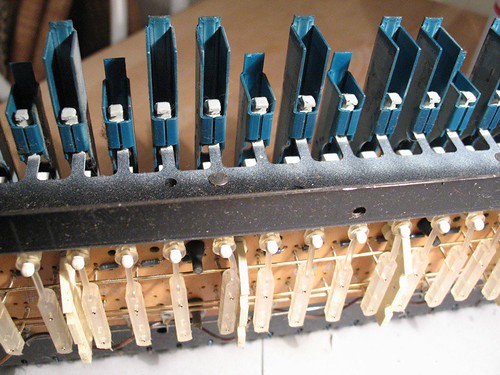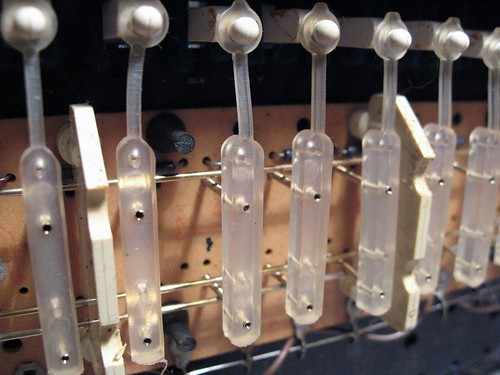 One thing that I noticed a few weeks ago was that certain notes on the Minimoog sounded strange when I played them. They sounded like the were cutting out, as if there was some kind of bad electrical connection. One particularly bad note would sometimes drift in an endless upward portamento, into tonal ranges beyond what you'd normally hear from a Minimoog. It made for a pretty cool effect, but not really what I wanted. Since I was going to have the keyboard out of the synth I thought I'd clean the part that's responsible for triggering notes.
One thing that I noticed a few weeks ago was that certain notes on the Minimoog sounded strange when I played them. They sounded like the were cutting out, as if there was some kind of bad electrical connection. One particularly bad note would sometimes drift in an endless upward portamento, into tonal ranges beyond what you'd normally hear from a Minimoog. It made for a pretty cool effect, but not really what I wanted. Since I was going to have the keyboard out of the synth I thought I'd clean the part that's responsible for triggering notes.If you look under the keyboard, as shown in these photos, you'll get a glimpse at the mechanism that triggers notes. I can basically explain how it works but here's where it becomes obvious that some areas of my knowledge are lacking. Pressing a key causes a plastic doohicky to pull a rubber thingamabob forward. These are the technical terms. Each rubber thingamabob has two gold contact springs attached to it. When the rubber thingamabob is pulled forward, the gold springs each come into contact with one of two gold buss bars that span the width of the keyboard assembly. One of the buss bars is for the pitch of the note, and one is for triggering the note. I'd like to know more about how this works, in technical terms (if anyone knows, feel free to share), but my speculation is this: the buss bar acts as a variable-strength resistor, which outputs increasing voltages at various contact points from the left to the right. When a spring makes contact with the pitch bar on the left (where the low notes are), a low voltage is outputted, which results in a low pitch. The higher the voltage, the higher the pitch. I'm just speculating. I'd love to know more.
 When I removed the keyboard from the synth it became obvious why certain notes were acting strange: the whole thing was filthy! There was dust buildup from over three decades of use. We're talking about BIG wads of dusty crap. Fortunately it was just dust - there was no evidence that anyone had ever spilled anything on the keyboard or anything like that. Most of the dust was taken care of with a can of duster spray.
When I removed the keyboard from the synth it became obvious why certain notes were acting strange: the whole thing was filthy! There was dust buildup from over three decades of use. We're talking about BIG wads of dusty crap. Fortunately it was just dust - there was no evidence that anyone had ever spilled anything on the keyboard or anything like that. Most of the dust was taken care of with a can of duster spray.If you're doing work on a vintage synth and you're thinking about using a commercial product such as spray-on contact cleaner or control cleaner, please take this word of caution. I was going to do the same thing (after all, the Minimoog service manual recommends a similar product called Cramolin, which I believe is no longer available), but I did a little research first. I came across a couple of threads on the official Moog forums that made me decide against using a spray-on cleaner on the buss bar, and I'll probably never use one anywhere on the synth again. The threads are here (the posts to read are by Kevin Lightner, a synth tech with a LOT of experience):
http://www.moogmusic.com/forum/viewtopic.php?t=3194
http://www.moogmusic.com/forum/viewtopic.php?t=2381
In the end I used Isopropyl Alcohol and some Q-tips. It worked really well, and ALL of my weird note issues have been solved.
The synth is looking and feeling better and better. The last step, as far as I can see, is to get a new wood case. It's currently being produced by an outfit called Synthwood. It's going to be beautiful, as you will soon see.

3 comments:
That's going to look amazing. Good luck with the rest of the restoration.
I wonder could you use deoxit on the contacts?
@Anonymous - I don't have any experience with Deoxit, but I recommend reading Kevin Lightner's comments about it on this Moog forum: http://www.moogmusic.com/forum/viewtopic.php?t=3194
Lightner recommends against using Deoxit or other similar products:
"Never use any Caig product on key contacts (or anything else in my opinion, but especially not on key contacts.)"
and
"[Caig products such as Deoxit] can screw up certain circuits such as glide and key memory and attracts dust that causes friction. Key contacts should be clean and dry, never lubed with anything."
Lightner is an expert with years of experience, so I trust his opinion here.
Post a Comment